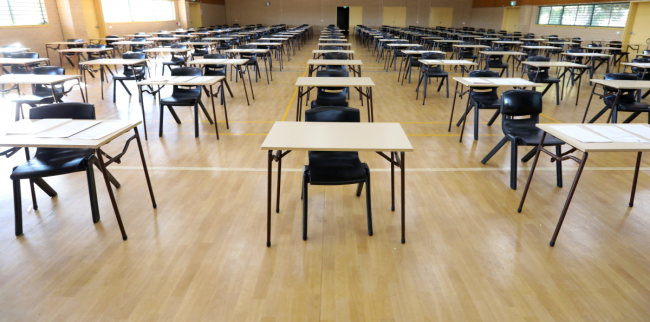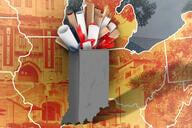You have /5 articles left.
Sign up for a free account or log in.

Istockphoto.com/Lincoln Beddoe
For the last five years, Williams College has had a 46 percent yield -- the percentage of admitted applicants who enroll. That's a very impressive number, reflecting Williams's spot as one of the top liberal arts colleges in the country. This year, Williams is expecting a 44 percent yield, seemingly a small change. But the change has had an impact on whom Williams let in.
Williams admitted 1,250 students, compared to an average of 1,197 for the previous five years. No one is suggesting that Williams let in undeserving students. At highly competitive colleges, many (if not most) of the rejected students could be admitted without fearing for their academic success.
Liz Creighton, dean of admissions and financial aid at Williams, said the coronavirus led college officials to expect the yield to go down slightly, and they admitted more students as a result.
Several factors went into the decision. "I'm conscious of the very specific challenges international students may face in terms of travel restrictions and the student visa process," she said.
Creighton also said that "campus visits matter tremendously, especially at a school like Williams, where the close-knit community is so central to the ethos." So Williams has expanded online options, but for some families, that may not be enough.
"We understand that for many families, those challenges I just mentioned barely scratch the surface of the incredible difficulties they're confronting right now," she said.
And Creighton may admit more. "We know that we'll likely admit more students from the waiting list than we have in the past few years," she said.
Top liberal arts colleges are ideal to watch calculations about expected yield this year. Many less competitive colleges admitted their classes before the coronavirus forced near universal shelter-in-place/no-travel orders in the United States. But top liberal arts colleges admitted their classes at the end of March, when the restrictions were fully in place.
Reed College admitted 3 percent more students this year (about 60 applicants). This brought Reed's acceptance rate to 39.5 percent.
Not all changes in the admit rate are entirely due to the spread of COVID-19. Monica Inzer, vice president of admission and financial aid at Hamilton College, said the admit rate there went from 16.4 percent to 18.1 percent. "We admitted roughly the same number as last year." But "that has more to do with the applicant pool being slightly down after a big jump and record high last year."
But Hamilton did make some changes. It admitted a few more January admits, "anticipating that could be a tougher sell or easier, depending on how things look for fall." And Hamilton extended its transfer deadline from April 1 to April 15.
But at Middlebury College, the admit rate this year was 24 percent, up from 17 percent, according to Nicole Curvin, the dean of admissions.
She said that Middlebury doesn't like to use the waiting list for admissions because "the wait list can be unreliable and interest can fluctuate depending on how other colleges proceed."
This year, she said, "the negative impact on financial markets, stay-at-home orders in different regions of the world, travel restrictions and the patterns of the spread of the virus are at play. We have to ask questions about whether our international students will enroll at similar levels and whether more domestic students will delay their enrollment to take a gap year. And these factors are changing daily with a different outlook from even a few weeks ago when we did our regular-decision release."
What the Experts Say
While colleges guess what their numbers will be, experts are watching and offering their own takes -- on all kinds of colleges.
"There is no doubt that the statistical models that have been built this year for any institution will not work perfectly moving forward. This is an unprecedented time," said Matt Maguire, vice president of client services and product development at Maguire Associates.
Madeleine Rhyneer, EAB's vice president and dean of enrollment management, said that finances will be key for many students. She noted that the University of the Pacific last week offered all full-time undergraduates a renewable grant of $1,450.
"It's a very proactive way" to reach the students, even those unaffected by COVID-19. "Everyone will appreciate it," Rhyneer said.
She also is thinking that colleges may be fearing -- too much -- that students won't travel for their college choice. Many surveys in March said that students would be likely to go to college close to home as a result of the health scare.
Rhyneer said that those surveys were as the coronavirus was just starting to make its impact felt in the United States. "I think as the weeks have gone by" there has been a change, she said. "It may have an impact, but not as dire as people first thought."
Wes Butterfield, vice president of Ruffalo Noel Levitz, said that while it is hard to generalize, he is urging most colleges to consider that they will see a drop of 10 percent in their yields this year. He said that he views most of the advice to colleges as ways to minimize their yield drops, not eliminate them.
Geography may also be key. "We've definitely seen a slowdown in the Northeast," which has been particularly hard hit by the coronavirus, he said.
In contrast, Butterfield said, he has one college in South Carolina that is not feeling the slowdown at all. Could students be looking for less-urban areas in the wake of the coronavirus?
And Butterfield also said that colleges, much as they want to open in the fall, need to start planning for the possibility that they can't. "I think every single campus should be planning for it," he said.
And he stressed that it need not be the entire semester. "We get caught up with semester," he said, "but there's nothing magical about September. What about October to start?"
Colleges may not be talking publicly about such scenarios, but they have to consider them, he said.
Craig Goebel, a principal with the Art & Science Group, said he too is seeing the biggest impact in the Northeast and the West Coast. But he stressed that "we've been finding varying results," with some colleges outside those areas doing well.
In this environment, "I think colleges should be asking themselves how much they can help" financially, and then communicate that to students, he said.
"We've never seen an economy hit like this before," he said.
Maguire said that colleges need to rebuild their yield prediction models. "There are some models that have to be rebuilt to exclude factors like campus visits, because many institutions receive lots of unique visitors in the final month leading up to the May 1 deadline," he said.
"Obviously, virtual campus visits will not have the same impact as an in-person visit, but it is still an important factor to track in order to assess late-cycle engagement," he said.
He also said "there is also a real question about the yield of students who are not quite in the Pell/state eligibility funding range," but are not close to making decisions about which college to attend without considering tuition and the availability of aid. Some of these students "already would have been stretched to make net costs of up to $20,000 to $25,000 … per year work for their family, and now COVID-19 might be leaving them in a place where wages/jobs have been lost or 529 funding plans have been wiped out."
All in all, he said, "every predictive model and the behavior of every student pool should be re-examined."




